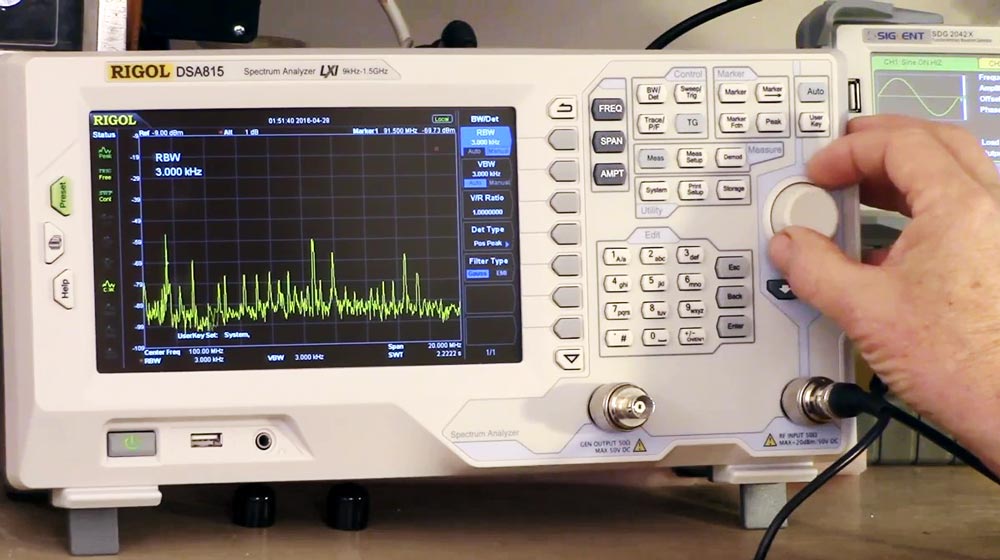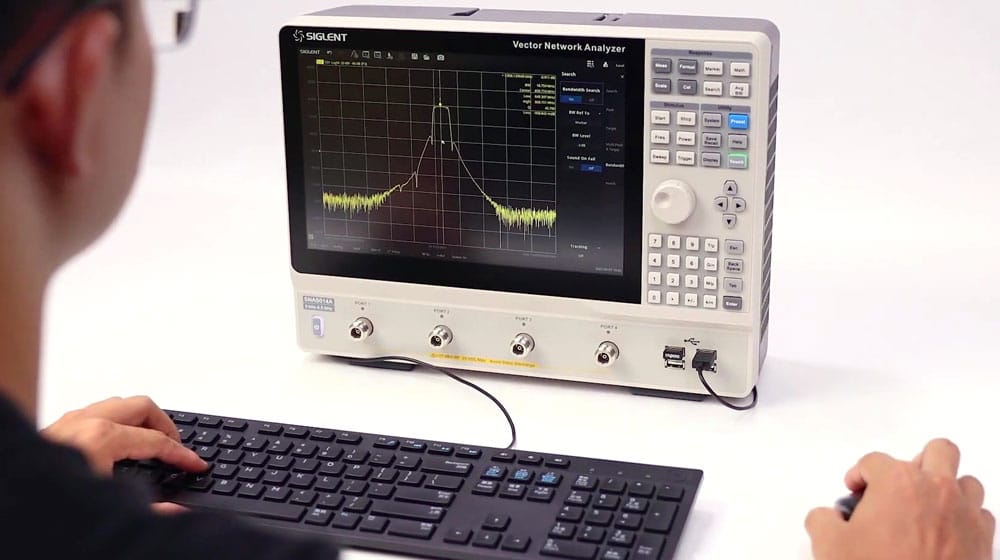A digital oscilloscope is used mostly by circuit enthusiasts and is known as the best device that you can use to capture, analyze, and study the features of electrical signals. Digital oscilloscopes can also be used in several other applications like medical instruments (ECGs), vehicle ignition systems, telecom engineering, motor vehicle testing, etc.
A digital oscilloscope works similarly to an analog oscilloscope, except that the former uses an ADC, or analog-to-digital converter, for converting the voltage into readable digital form. The oscilloscope will make use of a sampling system to capture the incoming waveform and will keep storing them until there are enough samples that can be represented in a waveform.
Additionally, the signals can also be viewed through different parameters like magnetic strength, current, and voltage. The tool is considered an important part of academics and researches, as signals need to be studied for almost all types of devices.
1. Siglent SDS1104X-E 100Mhz digital oscilloscope – Best Digital Oscilloscope
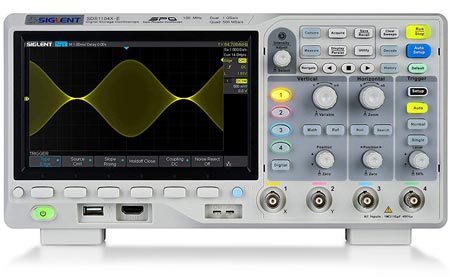
Siglent SDS1104X-E 100Mhz digital oscilloscope
- 100Mhz, 4 channels, 1Gsa/use, 1Mpts fft
- Standard decoder: iic, spi, uart/Rs232, can, lin
- 16 digital channels (mso) (four channel series only, option)
- USB AWG module and USB WIFI adapter
The Siglent SDS1104X-E is considered one of the most advanced digital oscilloscopes in the market today. It is fitted with some of the best features and is known for its impeccable performance. Additionally, it also features an in-built webserver.
The SDS1104X-E offers 1Gs/sec at two out of four channels, low-signal noise levels, a responsive user interface, 14 divisions on the signal grid, and 100MHz bandwidth.
Best features
While the SDS1104X-E is a bit on the expensive side, it is definitely worth the money due to its amazing performance; its performance is considered the best in the market. For instance, its sampling rate is 1Gs/sec at two channels. Additionally, when it comes to the four-channel sampling rate, the SDS1104X-E is considered much better than some options.
Additionally, the tool is built with a powerful in-built webserver. It is one of those few oscilloscopes that will provide you with a decent update speed so that you can view the signals on your computer easily.
- The SDS1104X-E features a large screen with color-coding
- The record length is 14Mpts, which is quite impressive
- On the right of the screen, you will see a bode plot
- SPO technology is used to power the SDS1104X-E
- The fan of the scope is a bit noisy and may get annoying
- At times, you may end up shifting the 1X/10X switch by mistake

Rigol DS1054Z Digital Oscilloscopes
- 50MHz, 1GSa/s, 4CH, 24Mpts, Free Trigger and Decoding DSO
- Innovative “UltraVision” technology
- Up to 60,000 frames hardware real-time waveform recording and playback functions
- Low noise floor, vertical scale range: 1 mV/div to 10 V/div
- Various interfaces: USB Host and Device, LAN (LXI), AUX
2. Rigol DS1054Z Digital Oscilloscopes – Best Digital Storage Oscilloscope
The Rigol DS1054Z is another popular entry-level oscilloscope available in the market. It is fitted with a 7-inch high-resolution screen, different mathematical functions, 100MHz bandwidth, and four channels. Additionally, it is also quite pocket-friendly, which makes it quite a bang for your buck.
Best features
The scope of the DS1054Z is compact and fairly small; however, the design is quite sturdy. Additionally, the buttons are also responsive and sensitive. On the screen, you will see a tooltip-like functionality – the big green buttons will explain what the purpose of each function is.
The DS1054Z also features in-built mathematical operators, which can help you outsource some of the data that you have analyzed and gathered to your computer, with the help of a USB cable. There is also a wide range of capabilities like a USB host to save the waveforms via screen captures, statistics and measurement capabilities, triggering of decoding capacities, and a pass/fail output.
- The screen measures seven-inches, with 800X400 px resolution
- Depending on the model, the bandwidth may measure anywhere between 50MHz and 100MHz
- The memory depth measures 12Mpts, which is upgradable to 24Mpts
- The oscilloscope is fitted with in-built mathematical operators and FFT
- The ventilation fan is quite noisy and irritating
- While the user interface is easy to read and intuitive, some options may feel convoluted
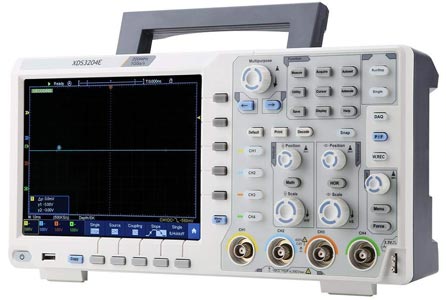
OWON XDS3204E Digital Oscilloscope
- 200MHz Bandwidth,1GS/s sample rate
- 12-bit high resolution ADC
- 40M record length 45,000 wfms/s waveform refresh rate
- 8 inch 800 x 600 high resolution LCD, multi-touch screen, more user-friendly operation experience
- SCPI, and LabVIEW supported
3. OWON XDS3204E Digital Oscilloscope – Best Digital Oscilloscope Kit
If you are looking for the best digital oscilloscope, then you can opt for the OWON XDS3204E. While it is a bit on the expensive side, you will definitely not feel like you are wasting your hard-earned money on a cheap oscilloscope.
Best features
The XDS3204E offers a bandwidth of 200MHz, which means that you can easily use it for serious troubleshooting operations and testing. However, the operation is quite simple as even beginners will be able to use the scope conveniently.
One of the most important advantages of the XDS3204E is that the device is quite large, especially when compared to other oscilloscopes in the same price range. Thanks to this, you will be able to view the waveforms much easily. Specifically, the LCD screen measures about eight inches and has a resolution of 800×600 px.
The XDS3204E also has a capture rate of 45,000 wfms/s and a sample rate of 1Gs/s, which is quite impressive. Additionally, it also has a 12C function, which will prove to be quite useful for working with communication issues and also test functions for different protocols.
The scope has a very ergonomic shape and includes a touch-screen for easy navigation and button controls. Thanks to the intuitive design, you should be able to use the scope quickly.

- There is support for SPI and LabVIEW
- The quality of the screen is clear and crisp
- The user interface is quite intuitive
- The scope is quite expensive
4. Siglent Technologies SDS1202X-E 200 MHz Digital Oscilloscope – Best Digital Phosphor Oscilloscope
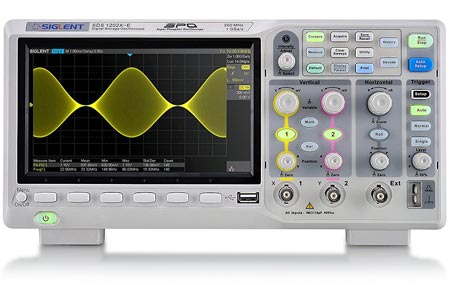
Siglent Technologies SDS1202X-E 200 MHz Digital Oscilloscope
- 200 mhz bandwidth
- Real-time sampling rate up to 1 gsa/use
- IRecord length up to 14 Mpts
- Standard serial bus triggering and decode, supports iic, spi, uart, Rs232, can, lin
The Siglent SDS1202X-E is considered one of the most useful oscilloscopes that can be used for a wide range of professional works like auto repair, physicists, healthcare, electronic technicians, and engineers. The device can easily capture the electronic signals for comparing two different channels or detailed examinations.
Best features
The SDS1202X-E has been designed very ergonomically and features stabilizing rubber feet and a non-reflecting coating. Additionally, it also has a handle on the top for easy portability. Also, the oscilloscope can be tilted so that you have a decent viewing angle and fitted with lit-up buttons.
The SDS1202X-E also has something that is not found in other types of scopes in the same price rate – 256 intensity grading and color temperature display.
With the help of this function, the trace occurrence will be displayed in different colors instead of one. For instance, higher frequency events will be represented by red color.
- The coating is non-reflective
- The design of the SDS1202X-E is very ergonomic
- The measurements you get is very accurate
- The pricing is very affordable
- The SDS1202X-E only has two channels
- Could have been fitted with some more features
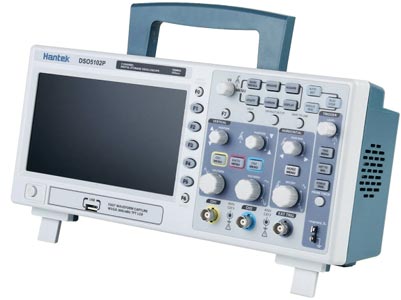
Hantek DSO5102P Digital Storage Oscilloscope
- 100MHz bandwidths;1GSa/s Real Time sample rate
- Large (7.0-inch) color display,WVGA(800×480);Record length up to 40K
- Trigger mode: edge/pulse width/line selectable video/slop/overtime etc
- USB host and device connectivity, standard
5. Hantek DSO5102P Digital Storage Oscilloscope – Best Digital Oscilloscope USB
The Hantek DSO5102P is a top oscilloscope and is considered quite a beauty. Additionally, it is not very expensive as well. For an entry-level scope, the DSO5102P has very impressive specs.
Best features
The company has been around for about a decade and has been known to manufacture a wide range of test instruments. The scope is portable and fitted with several great features like 1Gsa/s channel storage (dual). All you need to do is tap on the measure button to get voltage, period, frequency, etc.
The dual-channel scope has a sample rate of 1Gsa/s and a bandwidth of 100Mhz, which you can view on the seven-inch LCD. It is fitted with different trigger modes and can record up to 49K samples. It is also fitted with a USB host that can be connected to a computer for real-time analysis. It also has many automatic features that will make the DSO5102P even more convenient.
Both channels can be used to record the samples simultaneously. The DSO5102P is also fitted with two scope leads for in-depth and real technical results. The pricing of the device is very cheap and fitted with a trigger mode that can help you capture any kind of frequency.

- There are two probe channels, which makes it perfect for first-timers
- The USB host will allow you to connect the device to your computer
- The seven-inch screen is glossy and well-designed
- The memory depth is 40k, which helps in improving the sample rate
- The software for the device works very slowly
- Could have been fitted with some more features
What are the different types of digital oscilloscopes?
Digital oscilloscopes are mostly divided into four types, depending on the work. These include:
Digital Storage Oscilloscope (DSO)
When compared to an analog oscilloscope, the DSO is fitted with a digital memory for storing the data. However, unlike an analog oscilloscope, the DSO will use an analog-to-digital converter (ADC) to convert the analog data to a digital waveform.
The DSO can be used to measure the maximum frequency; however, this will depend on two important factors – the sampling rate of the scope and the converter’s nature.
On the screen, you will see the parameters period and input voltage in the X- and Y-axis, respectively.
Some controls will provide you with 3D-styled traces and also help you compare more than two waveforms. Additionally, most DSOs are fitted with internal memories to store the traces for reference later.
Digital Phosphor Oscilloscope (DPO)
The DSO makes use of a high-sampling ADC that captures the signals during acquisition. The repeated acquisition is not used to build samples for a signal. However, a DSO becomes a DPO if the deice adds the third frequency of occurrence, apart from the voltage and period axis.
A standard DPO can better process a signal than other conventional storage types, thanks to the variance in architecture. This is quite a unique architecture that features a parallel processing method, instead of the common serial processing method seen in DSOs.
In a DPO, the signal passes through a vertical amplifier and then goes through an ADC. On contrary to a DSO, a DPO is fitted with a parallel processor that captures and stores the waveforms. While a DSO could take more serial processing time, the signals are not limited in a DPO and can be captured while the activity goes on the display. Hence, the image you see on your screen will be much more intense and clear.
The processor found in DPOs can work parallel with acquisition systems for instrument control, measurement control, and display management so that the working of the device will not be affected by the scope’s acquisition speed.
Digital Mixed Signal Oscilloscope (MSO)
The desired digital channels can be put into different groups and the output will be provided as a bus, with each bus value provided at the bottom of the display in terms of ASCII, hex, or level of digital to analog testing.
The MSO device will provide you with all the functionalities of a logic analyzer as well as a digital oscilloscope. In most cases, a logic analyzer consists of 32 channels that can be used in parallel as well as serial bus protocols decoding and triggering.
As a logic analyzer, the MSO is fitted with channels that will convert the analog signals into digital format. Once converted, these signals will be displayed on the screen on any level and without any analog information.
Mostly, a logic analyzer is used to provide complete visibility of logic on a circuit. This is easily achievable since there is no involvement of an ADC. If you are looking for an analog version of the digital signal, all you need to do is connect any one of the analog channels.
Digital Mixed Domain Oscilloscope (MDO)
With the help of the time domain, you will be able to display decoded serial protocols, analog synchronized waveforms, and digital waveforms. As for analyzing the frequency domain, the circuitry is fitted with an integrated spectrum analyzer signal path.
The memory is also enough for long-time recording and can also attain versatile triggering. MDOs are fitted with an arbitrary/function generator and an in-built spectrum analyzer.
Buying Guide
The type of digital oscilloscope you choose will depend on what you are looking for? Are the signals repetitive or single-shot? What is the highest frequency? What is the range of the lowest and highest amplitudes that the device can measure? Do you have to measure different signals simultaneously? Do you want to analyze the spectrum in the domain while using the instrument?
Apart from these technical questions, which will help you look for the correct type of oscilloscope, you will also understand a broader spectrum of the ability of the instrument like portability, throughput, etc.
Form factor
If you are looking for a portable handheld device, you will probably have to sacrifice quite a lot of features, and even accuracy. On the other hand, you can always go for a PC-based oscilloscope, which is packed with a lot of robust features, especially those that allow you to annotate data. However, these designs are quite niched when it comes to practical uses, due to their dependency on other electronics.
Most people are not looking for handheld oscilloscopes – hence, they typically choose a bench-top unit. You will get the highest performance, without having to deal with other components. However, the unit you choose will depend on how you plan to use it – from inside a vehicle or on-site?
Channels and bandwidth
You will notice that some oscilloscopes do not have the bandwidth for every voltage range. Therefore, you need to look over the datasheets carefully to ensure that has the precise voltage range that you are looking for is supported. Mostly, you will find the bandwidth written on the packaging of the product or will be displayed prominently. Most oscilloscopes will have measurements between 20MHz and 200MHz.
Additionally, you will also find four-channel and two-channel oscilloscope designs. If you choose the former, you will have to pay a little more for this extra piece of hardware. For higher bandwidth ranges, you may have to shell out more than $400.
Sample rate and memory depth
Digital oscilloscopes capture the data samples and save them in memory. Hence, the memory size will determine how long the oscilloscope will keep track of the single before it reaches its maximum capacity. In this case, you just need to know how much data is being stored. The rate of sampling needs to be twice the maximum frequency that you want to measure, at least for a spectrum analyzer.
You also need to remember that most manufacturers will choose specifications that sound best when describing their sampling rate. When you are looking for the best digital oscilloscope, the performance at all resolutions needs to be consistent.
Resolution and accuracy
Similar to other instruments that are used for measurements, accuracy is an important factor when looking for the best oscilloscope. Additionally, the accuracy of your oscilloscope will depend on the type of job you are working on.
The best oscilloscopes need to be capable enough to detect even the smallest changes in the signal strength, even something as small as 0.5%. However, you do not need very precise measurements with an oscilloscope; therefore, most of these instruments will often provide about 3-5% DC accuracy.
Of course, you will find instruments that will provide you with accurate readings, but you will have to pay that much more. Hence, the measurements do not need to move between 3% and 1%, you can save substantial money by choosing the 3% one.
Inputs and probes
As compared to PC-based oscilloscopes, digital oscilloscopes will provide you with a decent range of selectable inputs that will measure between ±50 mV to ±50 V. You can also make use of an attenuating probe to measure higher voltages.
However, you need to make sure that the scope has sufficient voltage for signal types you wish to measure. For instance, a 16-bit scope can measure 256 times the same resolution as an 8-bit scope, thereby providing you with a better ability to zoom into a microvolt signal.
Best Digital Oscilloscope – Conclusion
A digital oscilloscope is considered one of the most common types of test equipment used in any electronic lab. They are considered very versatile and can be used to measure any type of measurements. If you are looking for the best oscilloscopes, you can choose any of the above-mentioned models.
Did you like our Best Digital Oscilloscope review? Please let us know and don’t forget to check our other reviews.
Best Logical Analyzer – could be interesting for you!



